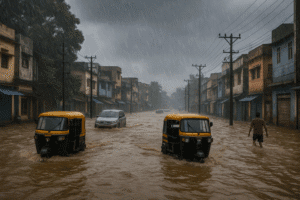Monsoon Fury Unleashed: 10 Shocking Impacts of Torrential Rains Paralyzing India’s West & South
Relentless monsoon rains triggered severe flooding, infrastructure damage, and tragic loss of life across western and southern India on June 16th. Mumbai faced major disruptions as heavy downpours crippled flight operations and forced airline advisories, while nine districts in Kerala declared educational institution holidays under red alert warnings after extreme rainfall caused fatal landslides and rising rivers. In Karnataka, multiple districts shut schools amid orange alerts, with a 100-year-old woman killed by a collapsing wall in Shivamogga and Bengaluru’s notorious potholes resurfacing dangerously.
The deluge proved deadly elsewhere: four perished in Pune’s British-era bridge collapse, and two men died from electrocution after a storm-toppled tree hit power lines in Delhi. Authorities issued warnings for continued heavy rain along the western coast and in Assam’s Guwahati, highlighting systemic vulnerabilities in urban drainage and aging infrastructure exposed annually by the monsoon’s fury.

Monsoon Fury Unleashed: 10 Shocking Impacts of Torrential Rains Paralyzing India’s West & South
India’s southwest monsoon is unleashing its full force across western and southern states, triggering red alerts, widespread disruptions, and tragic loss of life. From waterlogged megacities to flooded coastal districts, the relentless downpour is testing resilience and exposing vulnerabilities.
Mumbai Grinds to a Halt:
- Heavy overnight rains caused significant waterlogging and disruption across India’s financial capital.
- Flight operations at Chhatrapati Shivaji Maharaj International Airport were severely impacted, leading to delays and cancellations. IndiGo issued a travel advisory urging passengers to allow extra time and expect delays.
- The IMD has issued a yellow alert for Mumbai today, warning of further heavy showers, while neighbouring Thane, Raigad, and Palghar are under an orange alert for very heavy rainfall. The city remains on high alert for the day.
Kerala on Red Alert:
- Nine districts (Kasaragod, Kannur, Kozhikode, Wayanad, Malappuram, Thrissur, Ernakulam, Idukki, Kottayam) have declared holidays for all educational institutions today as a precaution.
- Kozhikode, Kannur, and Kasaragod are under IMD Red Alerts (extremely heavy rainfall >204mm expected). Kozhikode faced heavy rain and gusty winds this morning, prompting warnings of waterlogging, landslides, tree falls, and power outages. Residents are advised to avoid non-essential travel.
- Central Travancore (Kottayam & Pathanamthitta) is reeling, with two rain-related deaths reported (a man swept away in a stream, another killed by a falling tree). Rivers are nearing danger levels, landslides have occurred, and pilgrims have been warned.
- Coastal erosion continued for a third day in Ernakulam, and mining operations are suspended in Kottayam until June 17.
Karnataka Feels the Deluge:
- Orange Alerts are in effect for nine districts (Belagavi, Dharwad, Gadag, Haveri, Uttara Kannada, Udupi, Dakshina Kannada, Kodagu, Shivamogga).
- School and college holidays were declared in Udupi, Dakshina Kannada, Shivamogga (specifically Sagar and Hosanagar taluks), and Kodagu (though PU exams proceed). Chikkamagaluru, Hassan, and Shivamogga saw heavy rains causing landslides and traffic disruptions.
- Bengaluru’s perennial pothole menace has resurfaced with a vengeance after initial monsoon showers, making key roads like Kanakapura Road “unmotorable.” Residents complain of ineffective, temporary repairs.
- Tragedy struck in Shivamogga taluk where a 100-year-old woman, Siddamma, died, and two others were injured when a house wall collapsed during heavy rains on Sunday night.
Wider Impacts and Incidents:
- Pune Bridge Collapse Tragedy: Four people, including a 6-year-old boy, died, and over 40 were injured when a century-old British-era iron bridge over the Indrayani river near Kundamala village collapsed on Sunday. Tourists reportedly ignored safety warnings. Six victims are critical. CM Fadnavis announced ₹5 lakh ex-gratia.
- Delhi: After Sunday morning rains brought respite, the city started warm on Monday (min 29°C). IMD issued a yellow alert for thunderstorms and gusty winds. Two men died from electrocution in R.K. Puram when a rain-uprooted tree fell on a power line near their food stall early Sunday.
- Ayodhya: Light rain and gusty winds provided relief from intense heat.
- Guwahati: IMD predicts cloudy weather with heavy to very heavy rainfall likely over the next 2-3 days, raising risks of waterlogging, traffic jams, and localised landslides. Emergency services are on alert.
- Andhra Pradesh: IMD forecasts thunderstorms and gusty winds (30-50 kmph) with isolated heavy rain in North Coastal AP and Yanam until June 19. Light showers were recorded in a few places Monday morning (Kavali: 41.75mm).
- Wayanad Rainfall: After four drought years, the district recorded exceptionally high rainfall (June ’24-May ’25), with Lakkidi getting 7,611 mm. Experts attribute this to normal monsoon onset in 2024 followed by an early onset in 2025.
The Human Cost & Systemic Flaws: Beyond the statistics, the monsoon exposes critical vulnerabilities:
- Aging Infrastructure: The Pune bridge collapse and Bengaluru’s crumbling roads highlight deadly neglect and poor maintenance.
- Urban Planning Failure: Chronic waterlogging in Mumbai and Guwahati points to inadequate drainage systems.
- Preparedness Gaps: Despite annual monsoons, electrocution deaths and delayed responses to landslides persist.
- Economic Disruption: Flight cancellations, halted film shoots (like Kantara in Hosanagara), and lost work/school days take a cumulative toll.
Looking Ahead: The IMD predicts continued heavy rainfall along the west coast (Konkan, Goa, Madhya Maharashtra) and in Saurashtra & Kutch from June 18-21. Gujarat is also expected to see rain. Residents in affected areas are urged to stay updated on alerts, avoid floodwaters and landslide-prone zones, and heed official advisories. The need for resilient infrastructure and effective disaster management has never been more apparent.
You must be logged in to post a comment.